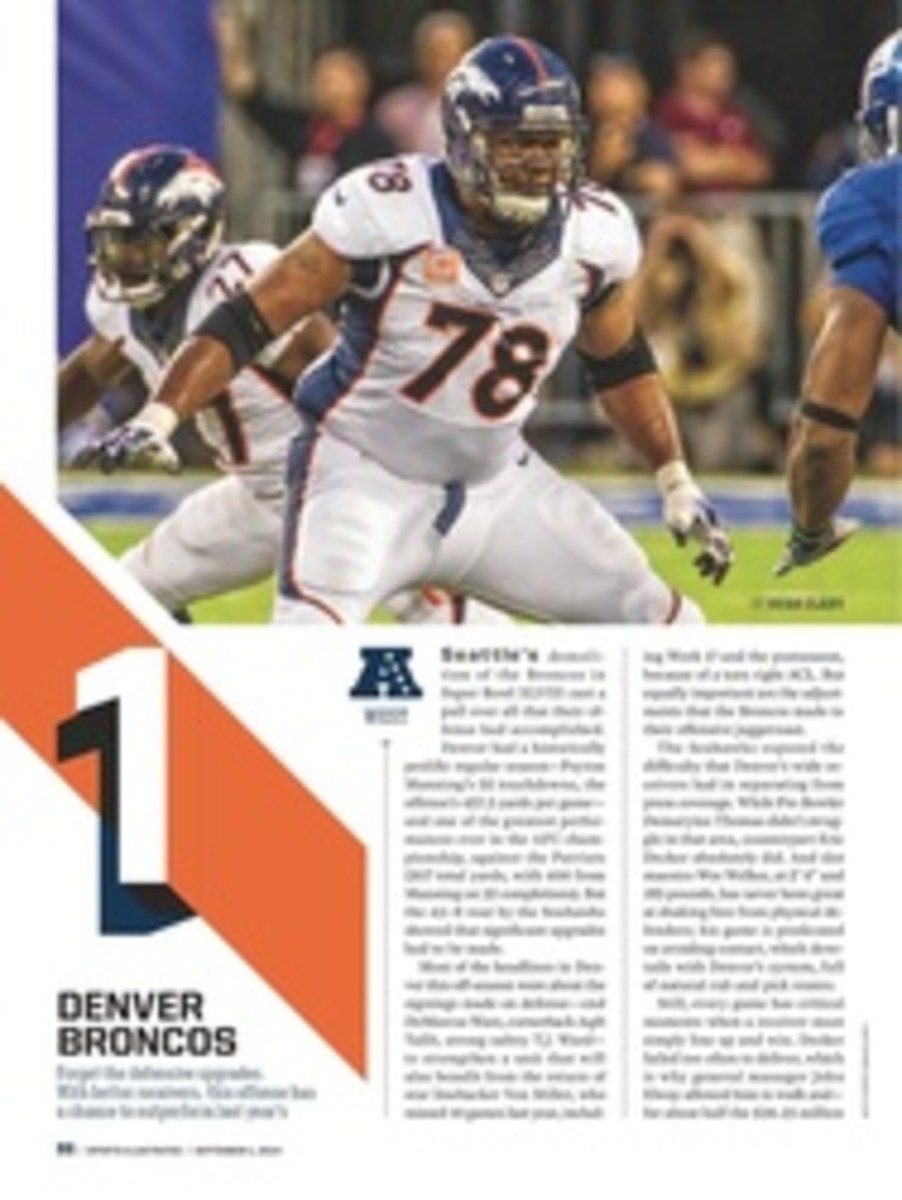
3 WASHINGTON REDSKINS
In his first year as an NFL head coach, Jay Gruden faces the same critical question that has haunted anyone who ever oversaw Michael Vick and watched him get pummeled: How much do I let my quarterback run?
As was the case with Vick, running is not something you can completely take away from Robert Griffin III; it's the most dangerous facet of his game. But just as with Vick, the more Griffin runs, the more punishing hits he absorbs. Griffin is listed at 6'2" and 222 pounds, but he plays much frailer than that because he has little sense of how to protect himself, especially in the way he hits the ground.
Most of the big shots that Griffin has endured have actually come in the passing game. Still, Gruden has already indicated that his offense will employ less read-option this year than it did under Mike Shanahan. Not only will that reduce the number of times Griffin is smacked on runs, but it will propagate a more sophisticated passing attack, reducing the blows he takes on dropbacks too.
The downside of the read-option has always been that while it can put edge run defenders in a bind, it also creates simplistic pass designs that rely almost entirely on deception. Under Shanahan, if the pistol play-action didn't work, then Washington's entire offense didn't work.
Gruden must teach Griffin not to scramble so often. When a quarterback runs frequently, it becomes difficult for his 10 teammates to develop any sort of continuity. Week-to-week rhythm disappears. (This partly explains why so many of Vick's coaches tried to turn him into more of a pocket passer.)
Griffin will find this challenging. With a bulky right knee brace forcing the quarterback to stay in the pocket last season, a harsh truth was unmasked: At this point Griffin is a one-read passer, meaning that if his first option isn't open, his inclination is to scramble. There has never been a consistently great NFL quarterback who wasn't capable of dropping back and making at least three reads.
A major reason Griffin remains undeveloped as a progression passer is that his pocket mechanics are underdeveloped. His footwork is uneven, as are his senses of spacing and timing when the pocket naturally compresses (which is almost every down in the NFL).
Washington GM Bruce Allen presumably tapped Gruden in part because he believes the 47-year-old can develop RG3. Previously, as the Bengals' offensive coordinator, Gruden did impressive work with a young Andy Dalton. Being a former collegiate and Arena league quarterback himself, and given his familial background (older brother Jon won Super Bowl XXXVII with the Bucs), he has a rich understanding of how to teach the position.
It will be much easier for Griffin to learn these things now that he has veritable weapons around him. Newly acquired wideout DeSean Jackson is not quite a true No. 1 (he struggles too much against press coverage), but he is a true home run hitter. Gruden will design plays with presnap motion and receivers aligning close to one another, crisscrossing off the line of scrimmage in order to help Jackson get a clean release. One overlooked benefit of having a burner like Jackson: He usually commands safety help over the top, which makes coverages easier to identify. That's a great way to accelerate Griffin's pocket passing development.
Opposite Jackson, Pierre Garçon is perfectly equipped to capitalize on what should turn out to be more single coverage underneath, where he'll continue to execute crossing patterns that highlight his run-after-the-catch ability. Garçon can also be a presence at the deep-intermediate levels, something that was missing from Washington's passing game a year ago.
The rest of the receiving group is deep: Free-agent pickup Andre Roberts (Cardinals) can boost the slot and fourth-round rookie Ryan Grant (Tulane) can push long-strider Aldrick Robinson and savvy veteran Santana Moss for playing time.
More exciting than perhaps all of those options is Jordan Reed, a third-round pick in 2013 who has a chance to become a top five tight end. A quick, fluid athlete, the 6'2", 236-pound Reed can consistently beat any safety (and especially any linebacker) in man coverage. To draw these matchups, Gruden will move him all over his formations, perhaps even into the backfield.
Couple this retooled passing attack with a sturdy Alfred Morris--led ground game and an offensive line that's younger and deeper at every spot around Pro Bowl left tackle Trent Williams, and you're looking at an offense that's capable of recapturing the NFC East—provided its quarterback can grasp that attack in a hurry.
2014 SCHEDULE
2013 Record: 3--13
WEEK 1
HOU [AWAY]
JAX [HOME]
PHI [AWAY]
NYG THUR [HOME]
SEA MON [HOME]
ARI [AWAY]
TEN [HOME]
DAL MON [AWAY]
MIN [AWAY]
BYE
TB [HOME]
SF [AWAY]
IND [AWAY]
STL [HOME]
NYG [AWAY]
PHI SAT [HOME]
DAL [HOME]
WEEK 17
THE BIG FIX
Getting flexible
By using their first draft pick on pass-rushing outside backer Trent Murphy (Stanford), Washington brass suggested that they plan either to soon move on from franchise-tagged Brian Orakpo or to create a unique long-term pass-rushing trio that would include athletic technician Ryan Kerrigan. Regardless, they have options, and that seems to be what's most important to coordinator Jim Haslett. Further evidence of an emphasis on flexibility: the guaranteed $10.5 million the team paid free agent Jason Hatcher, 32, to bolster its D-line. Hatcher just had a career year in Dallas after being used as a gap penetrator for the first time; his arrival will trigger more attack-oriented concepts for Haslett's 3--4 based line. Alongside Hatcher, Barry Cofield moves very well for a nosetackle, and he shot gaps at times with the Giants. Such adaptability along the line and among the 'backers will enable Haslett to use his full repertoire of front-seven schemes.
THE CASE FOR
Defensive coordinator Jim Haslett
Statistically, Haslett's D has been unimpressive the past two seasons: 31st in yards per pass attempt in 2013; 28th in total yards the year before. But new coach Jay Gruden kept him because Haslett runs an unpredictable scheme that offenses hate preparing for. In part to compensate for subpar secondary personnel, Haslett has used some aggressive ploys. On one play his D will crowd the line, only to drop into an eight-man hybrid zone; on the next it might show soft coverage, only to bring an all-out blitz. Such tactics usually bring about risky, unfavorable defensive matchups—a linebacker on an inside receiver—but Haslett's thinking is: If you already have a bad matchup, why not live with a slightly worse one in exchange for a chance to wreak havoc elsewhere? Haslett's is a playmaker-friendly approach, which explains why he's comfortable deploying gamblers like cornerback DeAngelo Hall and strong safety Brandon Meriweather. With questions at free safety and inside 'backer in 2014, he will need these playmakers to rise up.
PHOTO
ANDREW HARNIK/THE WASHINGTON TIMES/LANDOV
WR DESEAN JACKSON
PHOTO
SIMON BRUTY/SPORTS ILLUSTRATED
NINTEEN PHOTOS

